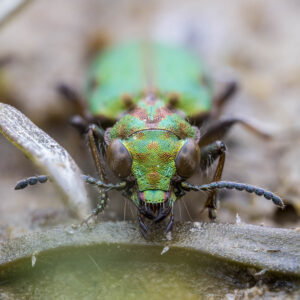On a mild, sunny afternoon in downtown San Francisco, office workers sit around a plaza eating lunch, for the most part oblivious to the fluttering around them.
Western tiger swallowtail butterflies are attracted to the plaza off Market Street, too, for its flowering cherry trees and London planes, a water fountain, and dappled sunshine.
“Right there — look!” said butterfly expert Liam O’Brien, bounding onto the scene as cheery as the yellow with black-striped lepidoptera around him. “It’s the largest butterfly in the county. It looks like it’s going for some nectar source. It’s unusual — what it’s doing in the most hostile part of the city?”
Repeat: What is the tiger swallowtail doing here? This butterfly species normally lives along a riverbank, making use of riparian hardwood trees as egg and caterpillar habitat, and the flowering plants as food for the adults. Downtown San Francisco is a far cry from a riparian corridor — or is it?

“Our species calls this a street. This species calls it the bank of a river,” said O’Brien. “That’s why this species is patrolling up and down Market Street like it’s the Colorado River through the Grand Canyon. The butterfly perceives it as a water concourse.”
O’Brien and his partner in this endeavor, Nature in the City director Amber Hasselbring, have started a campaign to enhance the habitat of this admirably adaptive species. They call it the “Tigers on Market Street Project,” as a parallel campaign to the Better Market Street Project, a multi-million dollar effort to reinvent San Francisco’s central artery.
O’Brien and Hasselbring are concerned that city officials and the architects behind Better Market Street are giving the butterflies short shrift in the planning.
“The new design may not accommodate the butterfly habitat adequately,” said Hasselbring. “It could mean taking out the trees — that’s what we’re concerned with.”

City officials are considering three options for the Better Market Street Project, one of which would require the complete removal east of 8th Street of a 40-year old canopy of London planes, a sycamore hybrid, to make way for a dedicated bicycle lane. The other two options would lead to the removal of only unhealthy trees, provided no other trees get damaged during construction.
“Under those two scenarios, the trees can be preserved if healthy,” said Neil Hrushowy, who leads the project at the San Francisco Planning Department. “And if sycamores are the ones we want to go forward with, that’s appealing — it saves money and preserves the urban forest.”
Which of the plans will the city choose? The process will involve an environmental review and several public comment periods. Obviously, the butterflies are one of many interest groups, and probably not the most vocal one. But O’Brien and Hasselbring want the butterflies to at least be a factor in discussions.

They would like to see the city preserve the mature London planes, or at least replace them with butterfly-friendly hardwoods. And the city could use more nectar sources downtown — hanging baskets with the right kinds of flowers, rather than the typical, useless garden varieties.
“So that California buckeyes are here instead of dental parking lot plantings,” said Hasselbring.
Part of their strategy in making the case for the butterflies at City Hall is establishing some science. The butterfly duo

got a $3,000 grant to do field research on the butterflies, and on this particular day they were counting them and observing their behavior.
Spring is butterfly mating season, and males and females were jazzed up as they sought each other out. One bold female, the larger of the sexes, began cruising toward a glass window at the E-Trade Financial Center.
“She’s attracted to her own reflection. She thought it was a boy in the window,” said O’Brien. “That was fantastic!”
As part of a campaign to win over the public, the two have already prospected some art on the tiger swallowtail. O’Brien is also an illustrator, and Hasselbring has got a hand for graphic design. As part of the Art on Market Street program, Hasselbring designed a billboard on Market and 7th Street to illustrate the phenomenon, and they have sketches for bus stop signs and kiosks.
They definitely don’t want to be seen as anti-cyclist. They have an idea for a “butterfly brigade” whereby a Critical Mass of bicyclists cruise down Market Street wearing butterfly wings.
“It’s San Francisco, politics is theater,” said O’Brien.
Alison Hawkes is the online editor of Bay Nature.





